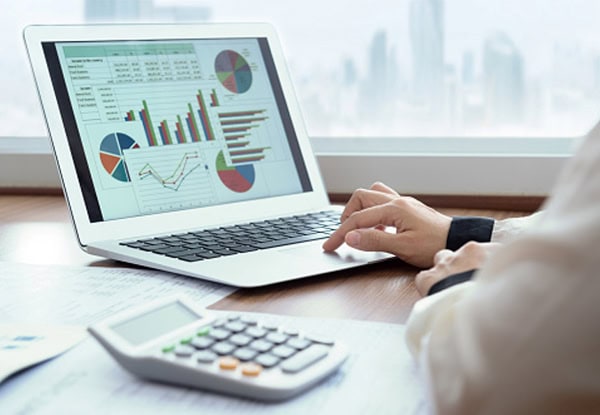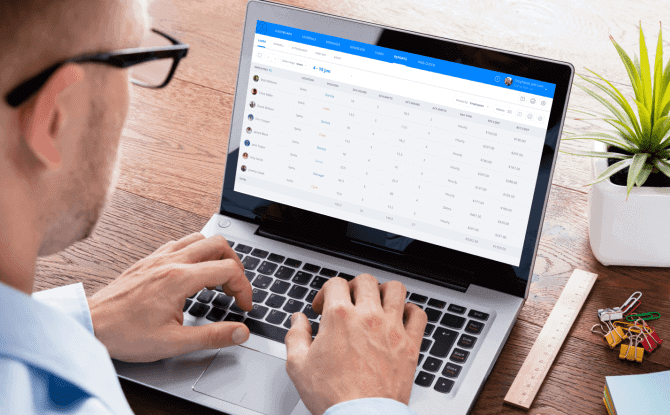How To Calculate Overhead Costs In 3 Easy Steps
To paraphrase a familiar expression: Nothing is certain but death, taxes, and ov...

Effective restaurant bookkeeping is essential if you want to ensure your operation’s success. With a comprehensive system in place, you’ll be better positioned to make informed decisions, control costs, and maximize profits.
In this article, we discuss how to get started with restaurant bookkeeping and the terms and practices that make it work.

Bookkeeping might not be your first choice of activities on a Friday night, but it’s extremely important if you want your restaurant to succeed. Think of it like a GPS for your money. With the right system, it can help you keep track of where everything is going.
Bottom line: Restaurant bookkeeping is the key to making smart decisions and keeping your business from hitting a financial dead end.
One of the easiest ways to understand the importance of restaurant bookkeeping is to simplify your activities down to a basic business like a lemonade stand.
With that lemonade stand, you sell 10 cups for $2 each. So, you made $20, right? But, wait, what about the lemons, sugar, and cups you bought to get you started?
If you spent $10 on supplies, you only actually made $10 in profit. Bookkeeping helps you keep track of all those little details so you see the real picture of your business activities.
For a full-scale restaurant, it’s even more critical because you’re dealing with hundreds, even thousands, of sales every day. You need to be able to see what’s really happening behind all those transactions.
Bookkeeping tracks every dollar that comes in from a customer and every dollar that goes out to pay for ingredients, rent, and employee payroll.
This gives you financial clarity so that you can see exactly how much profit you’re bringing in and how much you’re spending to keep the operation running smoothly.
Without good financial information, running a restaurant is like playing a game with a blindfold on. How do you know what to do next? You can guess, but guessing with your business’s money is a really risky move.
This is another reason why restaurant bookkeeping is so important: it helps you make informed decisions.
Let’s go back to the lemonade stand example. If bookkeeping shows you that your lemons are too expensive, you could decide to buy cheaper ones. Or, maybe you decide to raise the price for a full cup to offset the expensive lemons.
With data from your bookkeeping, you can make these decisions based on facts, not feelings.
Restaurant bookkeeping data can help you with all sorts of choices, including pricing, staffing, inventory, and others.
For example, are your prices high enough to cover all your costs and still make a profit? Are you paying too much in overtime? Or do you need to hire more people during busy hours to keep customers happy? Are you buying too much of one ingredient and having to throw it away?
Good bookkeeping helps you find the answers to those questions so you can make better decisions for your business.
Tax season can be a huge headache for restaurant owners. It’s like a pop quiz on your finances, and if you get it wrong, you could face big fines.
Proper bookkeeping makes the entire tax process much easier. Instead of scrambling to find receipts and invoices from the whole year, you’ll have everything organized and ready to go.
You’ll know exactly how much money you made and how much you spent on things like ingredients, beverages, supplies, rent, and employee wages; information that is essential for filing taxes at the end of the year.
Having an organized set of books can also help you find expenses you can deduct from your tax liability so you pay less overall.
Think of it like this: if you spent $5,000 on new kitchen equipment, that’s an expense you can use to lower the amount of profit you have to pay taxes on. Without good records, you might forget about that expense and end up paying more in taxes than you need to.
When your books are in order, you can do your taxes yourself or hand them over to a tax professional confident in the fact that everything is accurate and you’ve followed all the rules.
Cash flow is a technical term for the movement of money in and out of your business, and is the lifeblood of your restaurant.
Think of it this way: You can be profitable on paper, but if you don’t have enough cash on hand to pay for ingredients or rent, you’re in big trouble.
Bookkeeping is the best way to monitor your cash flow so that you can see when money is coming in and when it’s going out.
With an accurate system in place, you’ll be able to see if there are days or weeks when you were short on cash and plan and budget for those lean times in the future.
By tracking your cash flow, you can make sure you always have enough money to cover your expenses. This prevents you from running into problems like not being able to pay your suppliers or your staff.
Basically, good bookkeeping helps you avoid financial disruptions and keeps your business running smoothly. It can be the difference between a thriving restaurant and one that’s constantly worrying about how to pay its bills.

Restaurant bookkeeping — and accounting in general — can sometimes feel like trying to speak a new language.
You can make the process easier by learning a bit about the fundamental terms and metrics that are relevant to the restaurant business before trying to put them into practice.
For example, do you know what cost of goods sold, gross profit, and prime cost mean? Do you know how to calculate them? Committing this information to memory can help streamline the bookkeeping process and make it feel a little more accessible.
One of the best things you can do to ensure that your bookkeeping is accurate is to get help from an accountant.
Whether you hire someone to do the books for you or learn from them how to do the job yourself, consulting with a qualified accountant can help you gain a deeper understanding of the important numbers and financial processes that affect your restaurant.
Use reliable software
Regardless of whether you hire a full– or part-time accountant to manage the operation’s finances, it’s important to use reliable restaurant accounting software to keep track of your income and expenses.
In most cases, software can help you save time, improve accuracy, gain real-time insights, and streamline reporting for a more comprehensive accounting process.

Cost of goods sold (or COGS) refers to the amount it costs your restaurant to produce an item on the menu and can be figured using the following formula:
Cost Of Goods Sold = Beginning Inventory + (Purchased Inventory – Ending Inventory)
As a general rule, your cost of goods sold should make up about one-third of your restaurant’s total expenses.
Gross profit is the money your restaurant brings in after subtracting the cost of goods sold and is calculated with the following formula:
Gross Profit = Total Revenue – Cost Of Goods Sold
Gross profit margin is a percentage that essentially tells you how much your restaurant gets to keep from every dollar earned.
To calculate gross profit margin, use this formula:
Gross Profit Margin = (Gross Profit / Total Revenue) / 100
Ideally, you want the gross profit margin to be at least 70% — meaning the restaurant keeps $0.70 for every dollar that comes in.
Table turnover rate refers to the number of times you cycle customers through your tables. It’s calculated using the following formula:
Table Turnover Rate = Parties Served / Number Of Tables
This variable is an indicator of total revenue — the more people you can move through, the more money you can make.
If you find that your table turnover rate is low, look for ways to increase efficiency in the kitchen, move slow customers through their service, or even extend operating hours.
Revenue per available seat hour (or RevPASH for short) can help you determine whether the seating space in your building is arranged in a way that generates maximum profit.
To calculate RevPASH, use this formula:
Revenue Per Available Seat Hour = Total Revenue / (Available Seats x Total Operating Hours)
With this number in hand, you can start to think about ways to get more people into your restaurant (e.g., add another table or use smaller and more stools at the bar) in order to boost revenue.
Labor cost percentage can help you estimate how much your business spends paying employees — costs such as salaries, benefits, insurance, overtime, and payroll taxes — compared to the money it brings in.
Here’s the formula:
Labor Cost Percentage = (Total Labor Cost / Total Revenue) x 100
To make this calculation work, pick a time period (e.g., one day, one week, one month), figure out how much your restaurant spent on labor, figure out how much money it brought in, and then plug those numbers into the equation.
For more insight into how labor costs impact your business, check out these articles from the Sling blog:
Prime cost is an extremely important bookkeeping metric because it gives you insight into the two largest expenses you have direct control over: labor and food.
Calculate prime cost with this formula:
Prime Cost = Cost Of Goods Sold + Total Labor Costs
Prime cost can then be used to calculate a benchmark number: prime cost as a percentage of sales.
With your prime cost number in hand, divide it by your total sales and then multiply by 100. This will show you what percentage of your total sales go into purchasing food and paying your staff. Ideally, you want it to be 60% or less.
For more information on prime cost and how it can benefit your restaurant, check out this article from the Sling blog: Prime Cost: Why It Matters For Your Restaurant And How To Calculate It.

To keep everything organized in your restaurant bookkeeping, create categories for all of your income and expenses.
Common categories include:
When money comes in or goes out, enter the amount in your accounting software and tag it or mark it so that you can easily recognize which category it belongs in.
In double-entry restaurant bookkeeping, every financial transaction in your business affects two accounts: a debit account and a credit account.
Think of the debit account as the source of the funds and the credit account as the destination of the funds. A very simple example of a double-entry bookkeeping entry would be:
These entries are recorded in the same ledger (where the dollar amounts should match) and serve to ensure that your books are always balanced.
Talk to an accountant to learn more about double-entry bookkeeping and how it can benefit your restaurant.
Regardless of the amount of money that comes in or goes out, be sure to record those transactions every day.
This includes things like:
Entering your numbers every day can help you stay ahead of all the data that will come in the next day and make your restaurant accounting easier.
One of the most important activities in restaurant bookkeeping is keeping track of accounts payable and accounts receivable.
Your accounts payable is the money you owe to vendors, while your accounts receivable is the money others owe to you.
At least once a month — typically when you receive a bank statement — take the time to reconcile your accounts so that your records are accurate and match what the bank is telling you.
According to the Internal Revenue Service (IRS), a tip is a discretionary (i.e., optional or extra) payment determined by a customer and given to an employee for a job well done.
Tips can come in a variety of forms, including cash tips that customers give directly to your employees; tips customers add when they pay with a credit card, debit card, or gift card; items that have value, like tickets to a concert; or proceeds from a tip-sharing or pooling program.
All of the tips your employees get, whether cash or not, count as income and have to be reported to the government so you (and they) can pay taxes on them.
Here are a few other things to remember about tips:
If you have questions about what counts as a tip or how to set up a tip-sharing program at your job, you should talk to a lawyer who knows a lot about your industry.
For more information on keeping track of tips in your restaurant, check out this article from the Sling blog: Service Charge vs. Tip: A Guide for Restaurant Owners.

One of the largest and most impactful variables in restaurant bookkeeping is labor costs. Without proper tracking and control, these costs can have a dramatic effect on your business’s bottom line.
That’s where Sling comes in.
While Sling is not a replacement for a qualified accountant or accounting software, it can help restaurant managers and owners monitor and manage labor costs more effectively with tools such as:
Sling is an incredibly powerful employee management system that can help you organize and optimize team schedules and activities so that labor cost overruns become a thing of the past and restaurant bookkeeping gets easier.
To get started for free and to find out more about how Sling’s powerful scheduling, timekeeping, and task management features can transform your organization, your workflow, and your restaurant bookkeeping, visit GetSling.com today.
This content is for informational purposes and is not intended as legal, tax, HR, or any other professional advice. Please contact an attorney or other professional for specific advice.
See Here For Last Updated Dates: Link
Bookkeeping is the day-to-day process of recording daily sales, inventory purchases, payroll, and other financial transactions.
Accounting, on the other hand, is the broader process of analyzing, interpreting, and reporting on the bookkeeping data to provide a clear picture of your restaurant’s financial health.
The choice is entirely up to you, but many restaurant professionals use accounting software like QuickBooks to manage their day-to-day bookkeeping. Doing the books yourself can give you a better feel of how everything is working in your business.
There is, however, always a risk that you’re going to make a mistake, miss something, or skip over a new law or regulation.
Outsourcing to a restaurant-specific bookkeeper or accountant can eliminate these issues, provide a higher level of expertise, save you time, and help you improve profitability by providing advanced financial analysis.
Yes, a good POS system can help with the day-to-day bookkeeping in your restaurant. It can automatically track daily sales, categorize revenue (e.g., food vs. beverage), manage cash and card payments, and, in some cases, even track inventory.
Some POS systems also integrate with existing accounting software and allow you to automate much of the data entry and reconciliation processes for faster closeout at the end of the day.
Schedule faster, communicate better, get things done.